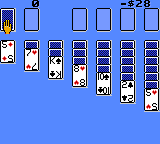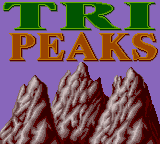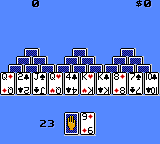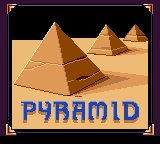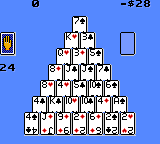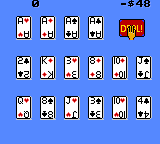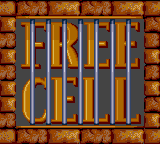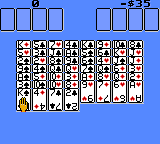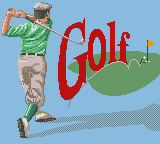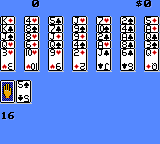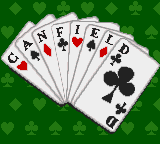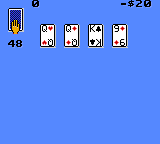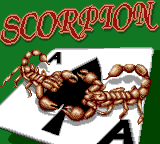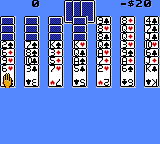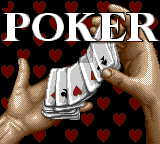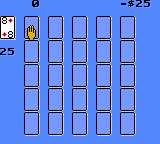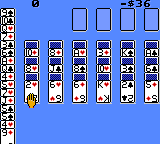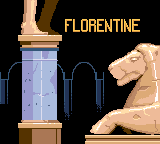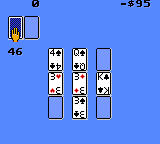Solitaire FunPak
From Sega Retro
| Solitaire FunPak | ||||||||||
|---|---|---|---|---|---|---|---|---|---|---|
| System(s): Sega Game Gear | ||||||||||
| Publisher: Interplay | ||||||||||
| Developer: Beam Software | ||||||||||
| Genre: Table | ||||||||||
| Number of players: 1 | ||||||||||
| ||||||||||
|
Solitaire FunPak is a set of solitaire card games for the Sega Game Gear. It was only released in North America in 1995.
Contents
Gameplay
The game collects twelve solitaire games, which are card games played by one player. Solitaire games typically involve organizing a deck of cards in the fewest possible turns. Games start with piles of unorganized cards (called a "tableau"), which must be moved to a location (called the "foundation") in some particular way, usually in ascending or descending order (sometimes but not always disregarding suit). The remaining cards in the deck (called the "stock") can be dealt out to help organize the cards in the required way. Cards cannot be moved after they are placed in the foundation. The player is generally limited in how many times the stock can be cycled (if at all). In most games, cards are ordered with the Ace lowest, then the numbered cards from 2 to 10, then the Jack, Queen, and King. All games have a timer to show how long the player has taken and a score depicted as a dollar amount. Most games cost points to start, so the player begins with a negative score.
In every game, the D-Pad moves the cursor over a card or pile of cards, ![]() moves the cursor to the stack, and
moves the cursor to the stack, and ![]() selects a card or confirms a location to move a card. In most games,
selects a card or confirms a location to move a card. In most games, ![]() twice moves a card to the foundation or discards it (depending on the rules). Pausing the game with START raises a menu that allows the player to restart the game with the same cards, restart the game with a reshuffled deck, undo the last move, or exit the game. Not all games are solvable, so the player may need to restart if there are no more moves that can be made.
twice moves a card to the foundation or discards it (depending on the rules). Pausing the game with START raises a menu that allows the player to restart the game with the same cards, restart the game with a reshuffled deck, undo the last move, or exit the game. Not all games are solvable, so the player may need to restart if there are no more moves that can be made.
Games
The player can select a game to play or play a tournament of multiple games, with the score carrying over between games. The Standard and Championship formats play through all twelve games, while the Custom and Custom Timed modes allow the player to choose which games to play.
| Klondike | ||||||||||||||||||||||||||||||
|---|---|---|---|---|---|---|---|---|---|---|---|---|---|---|---|---|---|---|---|---|---|---|---|---|---|---|---|---|---|---|
| Klondike is the most popular solitaire game (and often used synonymously with "solitaire"), though it has low rates of solvability.
The tableau has seven columns of cards, each one card longer than the last, with one card turned up and the others laid face down. The remaining cards are available in the stock. Cards must be organized face up and in descending order, without skipping any cards and with alternating red and black colors (regardless of suit), then placed in the four vacant spaces (the foundations). Only a King can be moved onto a vacant space. Cards can be moved individually or in a group (with the game determining which, if any, card in the column matches the destination). Face-down cards are turned over when the card above them is moved. The player can draw additional cards from the stock. At the start of the game, the player is given the option to show one or three cards at a time from the stock (with only the rightmost card available to play) and the option to cycle through the deck one, three, or an unlimited number of times. The game is won when all cards have been organized back into the foundations. The game is lost when there are no more moves that can be made. | ||||||||||||||||||||||||||||||
| Tripeaks | ||||||||||||||||||||||||||||||
| Tripeaks is a solitaire game that was designed to have a high rate of solvability compared to others.
The tableau starts with a pile of 18 cards face-down arranged into three pyramids, with a row of 10 cards turned up in front of them. The stock with the remaining cards appears below the tableau, with one card turned up (the foundation). Cards can be moved onto the foundation in descending or ascending order, regardless of suit (so an exposed 5 can have a 4 or a 6 placed onto it). An Ace can be placed on a King or vice versa. If there are no moves that can be played, a different card can be turned up from the stock. Cards in the pyramids are turned over when there are no other cards covering them. The game is won when all cards have been organized back into the foundation. The game is lost when all of the cards from the stock have been used but the tableau still has not been cleared. A counter shows how many cards remain in the stock. | ||||||||||||||||||||||||||||||
| Pyramid | ||||||||||||||||||||||||||||||
| Pyramid is a simple addition form of solitaire, with a low rate of solvability.
The tableau starts with a pyramid of 28 cards, all placed face up. The remaining cards are placed in the stock, to the left of the pyramid. Cards must be moved to the foundation to the right of the pyramid in pairs that add up to 13, regardless of suit. Jacks are worth 11, Queens are worth 12, and Kings are worth 13. So, for example, a Jack can be paired with a 2. Only the bottom row of the pyramid and the exposed card in the stock can be played. The game is won when all cards have been paired and moved to the foundation. The game is lost when all of the cards from the stock have been used but the pyramid still has not been cleared. A counter shows how many cards remain in the stock. | ||||||||||||||||||||||||||||||
| Cruel | ||||||||||||||||||||||||||||||
| Cruel differs from other solitaire games in that it lacks a stock, dealing out all cards in piles in the tableau.
The tableau consists of twelve piles of four cards each, placed face up. The foundations are placed above the tableau with four Aces initially in them. Cards must be moved to the foundation in ascending order by suit. Cards can be temporarily organized in the tableau in descending order by suit. Cards can only be placed on another card of the same suit. When a card is moved in the tableau, the card beneath it is exposed and can be played. Selecting "Deal" redeals all of the tableau cards, again in piles of four. The game is won when all the cards are on the foundation piles. The game is lost if no more moves are possible even if the cards are redealt. | ||||||||||||||||||||||||||||||
| Free Cell | ||||||||||||||||||||||||||||||
| Free Cell is a solitaire variant with a very high rate of solvability.
All 52 cards are arranged on the tableau in eight columns. Cards must be organized from the tableau to the four vacant spaces in the top-right (the foundations) in ascending order, regardless of suit. Cards can be temporarily stacked in one of the "free cells" in the top-left in descending order, again regardless of suit. A card can only be played if it has no other cards covering it. The game is won when all cards have been placed into the foundations. The game is lost when no more valid moves can be made. | ||||||||||||||||||||||||||||||
| Golf | ||||||||||||||||||||||||||||||
| Golf is a solitaire game with a simple layout and rules.
The tableau has seven columns of five cards each. The stock with the remaining cards appears below the tableau, with one card turned up (the foundation). Only the uncovered card at the bottom of each column can be played. Cards must be moved to the foundation in descending or ascending order, regardless of suit (but only a 2 can be placed on an Ace). When a King is played, the player must either play a Queen or flip a card from the stock (depending on the option chosen at the beginning of the game). Flipping a card from the stock adds another card to the foundation. The game is won when all cards have been organized into the foundation. The game is lost when all of the cards from the stock have been used but no more cards can be played from the tableau. A counter shows how many cards remain in the stock. | ||||||||||||||||||||||||||||||
| Canfield | ||||||||||||||||||||||||||||||
| Canfield, also called Demon, is a solitaire game with a notoriously low probability of winning.
A pile of 13 cards is stacked into a "reserve" pile on the left side of the tableau, with the top card available to play. Four columns with a single card are placed on the right side of the tableau. There are four foundations, with a random card placed in one of them at the start of the game; all of the other foundations must start with the same card. The remaining cards form the stock. Cards must be moved onto the foundations in ascending order, sorted by suit (with cards wrapping from Ace to King). Cards in the tableau can be placed in descending order and alternating color. Additional cards are taken from the reserve or the stock. At the start of the game, the player is given the option to show one or three cards at a time from the stock (with only the rightmost card available to play) and the option to cycle through the deck one, three, or an unlimited number of times. The game is won when all cards have been organized back into the foundation. The game is lost when there are no more moves that can be made. | ||||||||||||||||||||||||||||||
| Aces Up | ||||||||||||||||||||||||||||||
| Aces Up is a solitaire game that involves eliminating cards rather than organizing them into piles.
The tableau starts with a row of four cards, with all remaining cards in the stock. If there are two or more cards of the same suit in play, all but the highest ranked cards of that suit can be discarded, with Aces ranking highest. Then another four cards are dealt from the stock, with only cards at the bottom of a column with no other cards covering them in play. Any fully exposed card can be moved into a blank space when one is available. The game is won when every card but the Aces has been eliminated. The game is lost when there are more cards remaining than the Aces but no more cards can be eliminated. A counter shows how many cards remain in the stock. | ||||||||||||||||||||||||||||||
| Scorpion | ||||||||||||||||||||||||||||||
| Scorpion is a variant of solitaire similar to Spider, where almost all of the cards are laid out face-up in the beginning.
The tableau starts with seven columns of seven cards each. The first four columns have three face-down cards with four face-up cards placed over them. The remaining columns have their cards all facing up. The cards must be organized on the tableau in descending order, from King to Ace, by suit. Cards can be moved individually or in a group (with the game determining which, if any, card in the column matches the destination). Any cards below a matching card are moved along with it. There is no stock or foundation. The three leftover cards are placed at the top, face down, called the "merci." These cards can be played at any time, which moves them to the bottom of the first three columns. The game is won when all cards are organized in descending order by suit. The game is lost when no more valid moves can be made. | ||||||||||||||||||||||||||||||
| Poker | ||||||||||||||||||||||||||||||
| Poker, usually called Poker Squares or Poker Solitaire to distinguish it from the competitive card game, is a solitaire game where the goal is to build the most valuable poker hands possible.
The game presents a 5x5 grid of spaces, with a corresponding 25 cards in the stock. One card from the stock is exposed, and this card can be placed in any empty position (but cannot be moved once placed). The player places cards until the stock is emptied, then the value of each row is calculated into the player's score.
| ||||||||||||||||||||||||||||||
| Stone Wall | ||||||||||||||||||||||||||||||
| Stone Wall is a solitaire game that gets its name from the rows of "walls" that the player gradually uncovers.
The tableau is arranged in six columns of six cards each. Every other card is flipped over. The remaining cards are stacked in the reserve on the left side of the screen, face-up. Cards must be organized into the four foundations above the tableau in descending order with alternating colors (regardless of suit). Any card in the reserve can be selected and played. Cards can be moved individually or in a group (with the game determining which, if any, card in the column matches the destination). Face-down cards are turned over when the card above them is moved. The game is won when all cards have been organized back into the foundations. The game is lost when there are no more moves that can be made. | ||||||||||||||||||||||||||||||
| Florentine | ||||||||||||||||||||||||||||||
| The game is arranged with four tableau piles in the shape of a cross, with a reserve card in the center and four foundation piles placed in the corners. The top-left foundation is already started, and the other foundations must start with a card of the same rank. Cards must be placed in the foundations in ascending order by suit (with cards wrapping from Ace to King). Cards can be placed in the tableau in descending order regardless of suit. Cards cannot be placed on the center reserve card, but this card can be moved to the foundation or another pile in the tableau.
The game is won when all cards have been organized back into the foundations. The game is lost when there are no more moves that can be made. |
Production credits
- Executive Producer: Alan Pavlish
- Programmer: Clive Barrett
- Artists: Simon Hart, Greg Holland, John Tsiglis
- Music & SFX: Marshall Parker
- Director of QA: Jeremy Barnes
- Lead Tester: John Werner
- Testers: Matt Norton, Ron Austin, Shane Cleavelin, Yuki Furumi, John McGinley
- Producer: Wesley Yanagi
- Manual Text: Sean Kramer
- Manual Layout/Design: Bruce Warner, Salma Asadi
Magazine articles
- Main article: Solitaire FunPak/Magazine articles.
Physical scans
| Sega Retro Average | |||||||||
|---|---|---|---|---|---|---|---|---|---|
|
| 80 | |
|---|---|
| Based on 1 review | |
Technical information
ROM dump status
| System | Hash | Size | Build Date | Source | Comments | |||||||||
|---|---|---|---|---|---|---|---|---|---|---|---|---|---|---|
| ? |
|
256kB | Cartridge (US) |
References
| Solitaire FunPak | |
|---|---|
|
Main page | Magazine articles | Reception | |
| Interplay FunPak games for Sega systems | |
|---|---|
| 5 in 1 FunPak (1994) | Casino FunPak (1994) | Solitaire FunPak (1995) |


